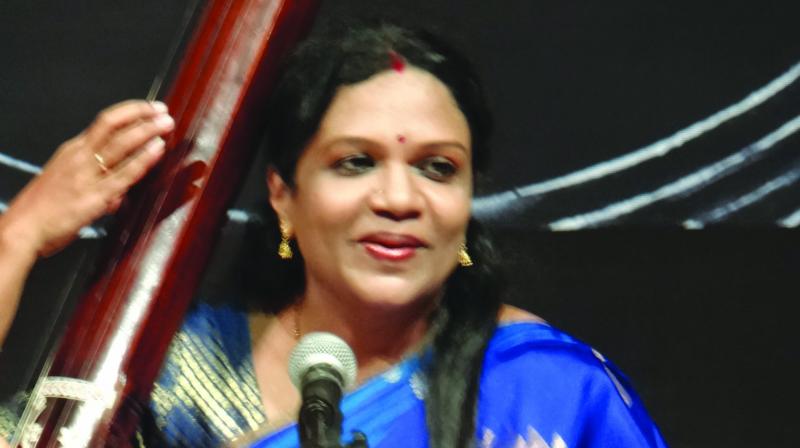Treasuring maestro Balasahib Poonchwale
The slow Jaipur taans in their dignity gave way to faster taans; Padma tai's music has so much of her own creativity

Pandit Balasahib Poonchwale, the doyen of the Gwalior gharana, died in 2005. He will always be remembered for his wide knowledge, especially his vast repertoire of “tappas” and their intricacies. Always a scholar musician rather than a concert performer, the doyen taught for several decades at the Madhav Music College in Gwalior; despite facing financial problems (he also had four daughters), he remained a very contented person. Simple to the core, he used to walk 5 kms every day till his end, according to his disciple Shashwati Mandal. She also shared how he was a prolific composer till the end; he had composed a “tapp bandish” in Bhairavi the year he died.
Shashwati was one of his two students, along with senior Guru bhai Jayant Khot who performed in his memory at a two-day festival in the Capital last week, organized by The Raza Foundation. Opening the festival, Shashwati Mandal who learnt from Balasahib ji from 1988 till his death, recalled fondly that even when her scholarship period ended and she could no longer pay his dues, he insisted she continue learning from him, without payment. Apparently a forward thinking man, despite belonging to an earlier era (he was born in 1918), the singer found no harm in his student listening to Western pop music in the background while studying and admitted he too listened to all types of music!
Shashwati Mandal, the granddaughter of Pt Balabhau Umdekar court musician of Gwalior, is now Delhi based. Her primary Guru was her mother, the late Kamal Mandal. She appropriately started her recital with Raga Marwa. Despite the short time at hand (her concert was under an hour) she resisted the temptation to straightaway launch into displaying her impressive repertoire of a variety of “taans” in differing speeds; instead she methodically built up a musical picture of the Raga, step by step. Marwa is a Raga of passion and pathos both, Shashwati managed to keep its “shakal”. It was a mature, satisfying recital, with flashes of “tayyari”, “layakari”, “bol baant”. She ended her recital with a fantastic “tappa” in Kafi, “man mat vaar ve miyan”, truly a delight. Her dexterous voice is well able to handle the twists demanded by a “tappa” which is a very virile, restless form. Amazingly, these same lyrics were used in a Khamach “tappa” too, and also in a “tappa” sung in Jogiya Kalingra. Shashwati shared how, though she had been taught the “tappa” in Khamach, her Guru Balasahib ji used the same lyrics in Kafi, and told her to sing this version. She ended in an “ati drut” composition, again in Punjabi “chado chado cheya meri baiyan”. Indeed she is very well taught; after the concert she recalled how she was made to keep repeating the composition from the beginning to the end, in faster speeds to get total control over this difficult style. On the tabla was the musically interactive Anil Moghe, Balasahib’s son-in-law. On the harmonium, keeping up with the musical thoughts as always was Paromeeta Mukherji. The evening ended with Pt Satyasheel Deshpande, whose main Raga was Mian ki Malhar.
The second evening started with a brief recital by Jayant Khot; the real delight was the wonderfully replete recital by Jaipur Attrauli doyen Vidushi Padma Talwalkar. Last year’s Sangeet Natak Akademi award winner, the prolific Guru also had the satisfaction of seeing her student Yashasvi Sirpotkar receive the SNA Yuva award in the same year! Padma tai as she is known as, sang a beautifully serene Bhupali, lingering on and holding the notes to create a meditative mood. The ultra slow Jaipur taans in their dignity gave way to faster taans; Padma tai’s music has so much of her own creativity that it cannot today be boxed into any one gharana style. She typifies how music should be sung — the notes being used in an inward journey creating an ambience of replete peace.
One does not need to exclaim in awe at the virtuosity; which is used in the building of a complete musical picture, not only to impress. The next piece Darbari was suitably grave and sombre; changing the mood totally. The doyen next sang a Holi. Providing vocal support was her disciple of around 10 years Ankita Deole, on the harmonium Dr Vinay Mishra and tabla Vinod Lele.
It was a pleasure to see several artists amongst the audience, from veteran Vidushi Shanno Khurana, Vidushi Rita Ganguly, Pt Madhup Mudgal, and Dr Chandrima Mazumdar amongst others.
Triveni Auditorium has a cosy ambience, with an excellent sound system.
